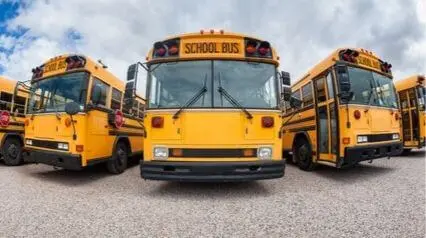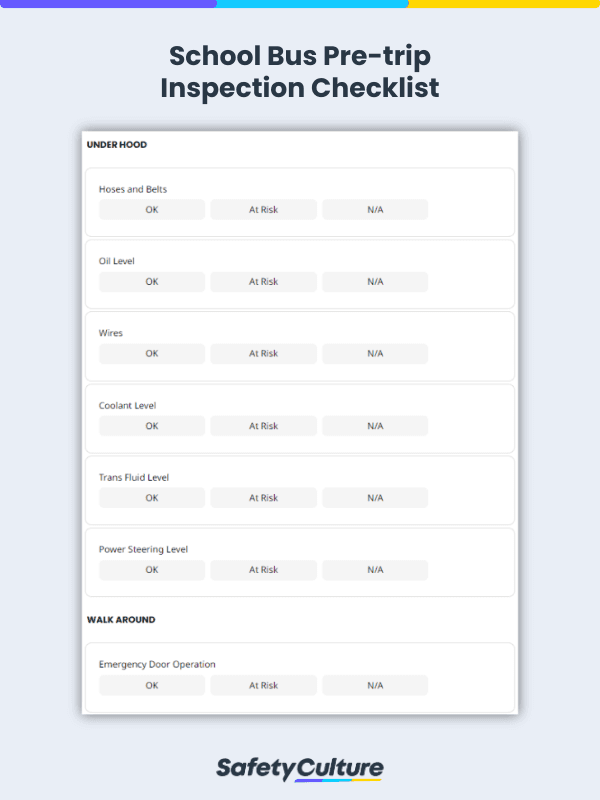What is a School Bus Pre Trip Inspection?
A school bus pre-trip inspection aims to determine if school buses are secured and operational before departing from the terminal. To identify any potentially unsafe conditions, bus drivers or fleet supervisors should perform regular checks to avoid any road-related incidents, massive vehicle damages, and unexpected vehicular costs.
This school bus pre-trip inspection checklist is composed of the following sections:
- Under hood
- Walk around
- Interior/pre-ignition
- Start engine
Click here for more on the checklist that can be viewed and downloaded for free.
What is a Class B CDL Pre-Trip Inspection?
Class B CDL Pre-Trip Inspections are certifying tests for acquiring a commercial driver’s license (CDL.) Pre-trip vehicle inspections are required by federal law (Section § 396) to ensure that vehicles like school buses are safe to operate, and verifies that it’s driver has the necessary knowledge and skills to operate it.
Class B CDL pre-trip inspections can be used by driving institutions to train license takers, refresh licensed truck/bus drivers, and by private or public institutions as a regular pre-trip inspection by using class B vehicles (e.g., straight trucks, buses, garbage trucks, dump trucks, delivery trucks and cement mixers.)
In performing a Class B CDL pre-trip inspection, it is imperative to determine any defects. Below are some bus defects that driver’s should pay attention to.
6 Major School Bus Defects that Need Immediate Action
School buses are classified as commercial vehicles that require pre-trip inspections to ensure roadworthiness. Performing a pre-trip inspection is paramount to keep an eye on the following crucial defects:
Oil Leaks
Oil leaks can cause catastrophic engine failure when left unchecked. They can get on seals and rubber hoses which can cause them to degrade prematurely. Moreover, oil leaks are environmental hazards that are prone to fire, engine failure, or crash.
Defective Brake Systems
Brakes are one of the most vital safety components of a school bus. When a brake system fails, it may lose the power to stop or slow down the school bus which can cause a major road incident. It is significant to check for damage indicators such as brake lights on, squeaking noises, vibration, and soft brake pedal to ensure brakes are operational.
Non-functioning lights
Non-functioning lights can cause accidents as they give signal to the vehicle behind whether you are having your turn or slowing down. Diagnose the following light issues: a) loose lightbulb socket, b) dual-filament bulbs, c) electrical disruption, and d) out-of-adjustment switch to confirm the cause of non-functioning lights.
Flat Tires
A flat tire can cause the rim of the wheel to ride on the tire tread that can lead to irreparable tire damage. It can instigate the loss of school bus control especially at high speeds which may lead to a road accident.
Growling Engine
Growling engine sound could mean that the air is trapped in the fluid of your school bus cooling systems. Unable to detect the reason may lead to overheating, cracking and warping the parts of your engine, cracked hoses, leaky water pump gasket, or fritz of power-steering pump.
Defective Seats
According to CBC News defective seats on school buses can put students at risk of injury or even death. Unable to comply with bus safety requirements can cause your business legal fines or worse business closure.
What to Look for in a Pre-trip Inspection?
By being aware of the previously mentioned defects and by using a pre-trip inspection checklist, drivers can be guided on what to look for every time they are going to complete a pre-trip inspection. Go through the following items based on this checklist to help ensure that the vehicle is going to be safe on the road.
1. Under Hood
Check under hood to make sure that the components are in good condition and that the oil, coolant, and trans fluid are at a good level.
2. Walk Around
Check for any damage on the emergency door, tires and wheel lugs, glass mirrors, exhaust system, and look for any fluid leaks.
3. Interior/Pre-ignition
Check the interior and inspect the following before you start the engine: fire extinguisher, fuses and reflectors, first aid kit, mirror, seat adjustment, seat belt, and seat condition.
4. Start Engine
Lastly, start the engine and check if the following are in good condition and working correctly: vacuum/air pressure/oil press, warning buzzers/brakes/emergency, amp gauge, temp gauge, fuel gauge, wipers and washers, and all the remaining components.



